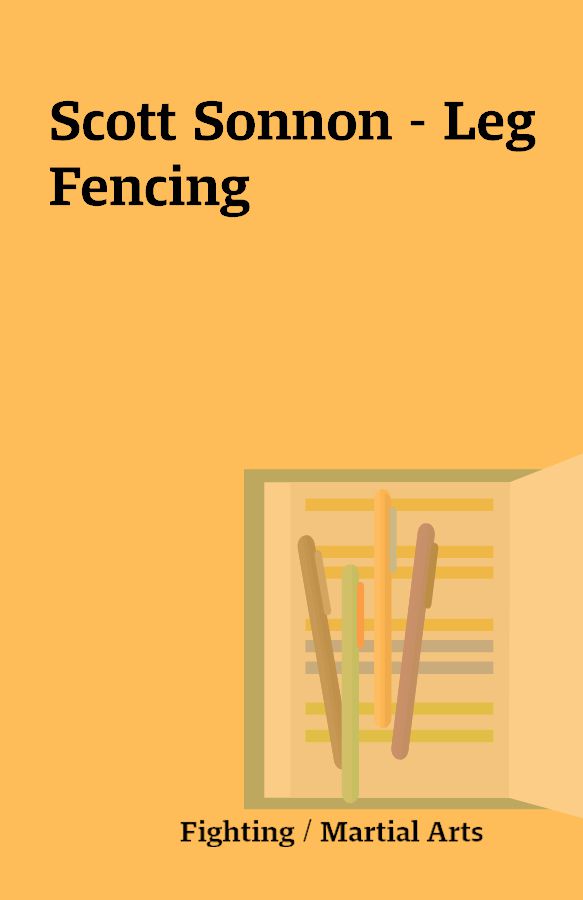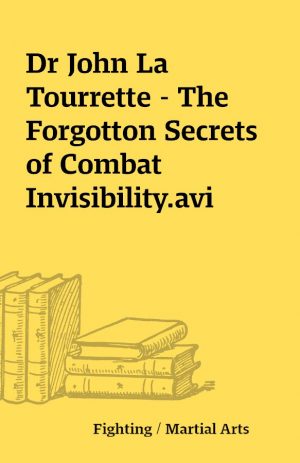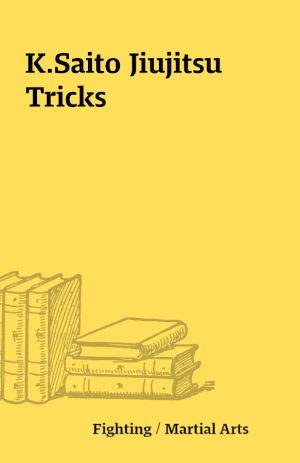Scott Sonnon – Leg Fencing
Scott Sonnon – Leg Fencing
[3 VHS – AVI]
Description
“When Scott Sonnon sent me a copy his three-tapeLeg Fencing™ set and asked that I do an honest review of it, I was a little intimidated. I’ll admit it: I tend towards a weakness that many in the martial arts have, and that is that I prefer striking with my hands to kicking with my feet. This is a natural bias in human beings, I think. We’re used to using our legs for little else than walking around, whereas we use our hands and arms for just about everything else.Well, growth can be both painful and unsettling — but it is worth it. If you’re looking to increase your leg flexibility, power, control, and speed, the Leg Fencing series is one you should consider.TAPE 1The first tape in the series, T.O.P. Tool Development, focuses on drills that help you build the foundation for Leg Fencing. Scott makes the distinction several times between this and what he calls “foot fighting.” Fighting with the legs as Scott teaches it is a whole-body endeavor that uses your entire physical “architecture.”Scott explains that the purpose of the tape’s exercises is to improve your T.O.P. — your Threshold of Performance. He refers once again to the definitions of “hard” work and “soft” work defined in his Flow Fighting video. “Hard” work is work that improves your threshold of pain, while “soft” work is work that improves your threshold of what Scott calls “fear reactivity.” Fear reactivity, he explains, expresses itself physically as tension. A relaxed fighter has better focus. “If you can’t stay relaxed in a force on force simulation,” Scott warns, “you won’t be able to stay relaxed in a fight.”The sound quality of instructional videos is almost universally mediocre. This tape was not much different. I had to increase the volume with each new segment in order to hear Scott, as the recording levels seemed to decrease each time. Apart from that the track was audible and I had no trouble understanding what was being said.Video quality is okay too, though the cloth backdrop used is lighted with different colored lights in a manner I found distracting and a little dim. I did not notice as many intermittent recording lines as I did in the Flow Fighting tape. Camera angles change as needed without becoming spastic or unsettling, with frequent close-ups on Scott’s feet and legs to illustrate techniques.The first solo exercise on the tape is a four-corner balance drill. Scott mentions the “visual search engine” and tells the viewer to imagine that an invisible tether connects his or her eyes to a spot on the floor. Looking around a lot will disrupt one’s balance, he explains — and proceeds to run through a series of movements while standing on one leg and moving or extending the other.I was absolutely amazed at Scott’s balance and control. He moves as if his body is on pulleys — though at the completion of the exercise he admits that it isn’t as easy as he makes it look. “You should feel an enormity of pain in your planted leg,” he says, smiling. “It should feel like your foot’s on fire.”Solo Exercise 2 is called “Leg Infinities.” It is intended to build foot strength (though it will also enhance knee strength). “If you want to excel at Leg Fencing,” Scott explains, “it has to come from the foundation first.” Once again balancing on his planted leg, he moves his mobile leg in a series of figure-eight patterns. “If there are bumps in the movement,” he continues, seemingly taking no notice of the exertion, “that’s where you have a limitation. That limitation is fear reactivity in your tissues.” That fear reactivity, as previously mentioned, is expressed as tension, which causes the limitation.If you can do only one of the exercises on this tape, Scott recommends Solo Exercise 3, the “Rock-up Deck Squat with a Kick.” That’s kind of a tongue twister, and I gather from the impish way Scott repeats it that he knows it is. The exercise is designed to improve your leg strength and flexibility while improving your ability to coordinate your respiration with the motions.The rock-up deck squat with a kick is not a Hindu Squat or a bar squat, but something better seen than described here. Scott talks the viewer through the exercise — but not before stating, “You will do them with me.” Between the carrot and the stick, Scott explains, he prefers the stick. I don’t imagine many of the athletes with whom he works would want to argue with his training suggestions, either. He has a way of being both incredibly friendly and undeniably motivating all at the same time.Making the transition from tool development to tool application, Scott demonstrates two shock absorption exercises. Shock Absorption 1, the “Battering Ram,” is “hard” work rather than “soft” work. Raising his leg, Scott pulls his knee back into his chest, exhaling with each impact. The battering ram exercise will improve your flexibility, your dynamic range of motion, and your ability to absorb blows.Throughout this exercise, as with all the exercises on the tape, Scott explains what he’s doing as he’s doing it. He points out common mistakes and problems, too, anticipating any difficulties the student may experience. Rarely, if ever, does his calm and self-assured voice waver, even when he’s explaining something in the midst of a strenuous drill. He’s so relaxed that it’s easy to forget he’s doing things that would have most of us howling over our sore muscles.The second shock absorption exercise is “Shin Lifts,” in which the battering ram exercise is applied to different ranges of motion. Scott emphasizes one of the most important concepts in all fighting, not to mention Leg Fencing: that of rooting into the ground to maintain your balance (and thus your ability to fight). He also stresses the importance of proper respiration. “Exhalation is the trigger for you to keep your presence of mind in melee,” he says.There are four different footwork exercises on the tape. In the “Accordion” exercise, Scott shows you how to drill using your entire foot for propulsion and balance. As always, he looks light on his feet and in superb control as he rotates his feet and shifts his weight from one to the other.The second footwork exercise, “Fencer’s Advance,” looks like just that — a means of advancing in a linear fashion. Scott builds on the previous drills as he explains this one. This is not new. Scott consistently builds on previous exercises as he explains new ones, which lends a nice sense of continuity to the training regimen he is outlining.In the third footwork exercise, “Slingshot,” Scott demonstrates how to store “elastic energy” in your rear leg. He withdraws his leg and “loads” it with elastic energy that can be released forward. One should make this movement habitual. “You don’t need a stance in order to be in balance,” Scott says. “Your balance is in motion. …Stability through mobility.”The fourth and final footwork exercise brings the other drills together in the “Box Step,” a balanced means of moving in which one foot steps forward as the other steps behind it. The body turns and the legs are constantly in motion, stepping through the pattern. The box step is never stationary, Scott says. It is a means of hiding your balance point through movement.The box step is not, however, a fighting technique. It is an exercise, and Scott threatens to hit you with the videotape if he ever catches you trying to make it a technique. Use the box step to develop rhythm, timing, and movement, he encourages.Bringing in a pair of training partners, Scott explains 5 “games.” These are partner drills that help one apply the skills developed through the previous exercises. In the first, the “Back to Back Push,” Scott’s assistants stand back to back and attempt to shove each other off screen. Both men drop down as they push, attempting to lower their centers of gravity for better leverage. Your ability to grip into the ground determines your ability to make a supporting leg and a driving leg, Scott points out. He refuses to reveal the secret of the exercise — but explains that it’s at the beginning of the video.In Game 2, “Arm-Lace Pull/Carry,” the two partners lace their arms and stand back to back before attempting to pull the other off camera. The drill repeatedly goes to the man who first lifts his partner off the ground and carries him away. The secret, Scott again hints, is at the beginning of the tape. “Rock-up deck squat with a kick,” he says quietly.The third game is a “Shoulder Push.” The opponents push on each other’s shoulders, as you might expect. I noticed that each time one of the men managed to push his partner off camera, the partner’s legs were bent but parallel. The “winner” of the exercise, by contrast, had his legs apart in a position similar to a simple Karate front stance. The difference in leverage between the two configurations is obvious.The fourth game is a “Wrist Pull,” in which the partners grab each other’s wrists and attempt once again to pull each other off camera. These exercises are fascinating to watch. You learn truly to appreciate the difference that leg placement, weight distribution, and body positioning make in one’s balance.I was also reminded of a balance exercise my own teacher and I have practiced that he calls “Indian Wrestling.” The drill teaches the importance of learning to yield when pulled or pushed. If you offer resistance, your partner has something against which to push to put you off balance. If instead you learn to give when force is offered, and to push or pull when tension is presented, you will win every time.In the fifth and last game, “One Leg cross-Wrist Pull,” each partner holds one leg up and behind him while grabbing the other’s free arm. The hopping tug-of-war that results is quite a sight — and makes one appreciate the four-corner balance drill.Scott concludes the tape by reminding the viewer that games should be fun. If you can’t laugh, if you can’t enjoy what you are doing, then you shouldn’t come back the next day. But fun does not mean the absence of challenge, Scott explains. The lowest common denominator in your training should be that all of the participants leave feeling fulfilled.This is a great cassette that will help you acquire and develop the skills, flexibility, strength, and coordination necessary to fight effectively with your legs. Scott is always enjoyable to watch and has a great on-screen presence.The material he imparts is clear, methodically presented, and adequately explained. It is not, however, easy to do. Work along with Scott while viewing this tape and your legs will be screaming for mercy long before you’re even halfway through.But, hey, you try telling him you won’t do it.TAPE 2AThe production values of Tape 2A are similar to those of the first tape. The sound level of the intro and outtro music is too loud when compared to Scott’s speaking voice, though this is a minor complaint. Closer shots of Scott and his training partners are fine, and the camera moves up and down as needed to capture torso and leg movement. Wide shots, in which the camera pans back to reveal more of the color-lighted background, appear a bit dim in comparison to the closer shots. Everything on the tape is visible and audible.The tape begins with a brief discussion of Scott’s formulae for “hard” work (the threshold of pain, or your effectiveness — opportunity over risk) and “soft” work (the threshold of “fear reactivity, or your efficiency — useful work over total work). We are, he explains, working towards two simultaneous goals: to increase our effectiveness while increasing our efficiency. If the best you can hope for in a fight is the worst you have managed in training, the only way to elevate the top is to lift the bottom.Scott explains the Threshold of Performance strategy for Leg Fencing: Secure, Shock, Saturate. (We are dealing with “attached striking” only in Leg Fencing — striking delivered while in the “clinch.”) Simply stated, this means taking a secure hold on your opponent, delivering disruption to your opponent through strikes or grappling, and following up by overwhelming your opponent.There are four elements to the clinch: a locking arm, a “power transfer” arm, a driving leg, and a mobile leg. In the clinch, you collect data about your opponent by feeling what he does. Where is he tense? Where is he pushing? Where and how does he flinch? These pieces of data reveal tendencies your opponent possesses that are specific to him. They’re habitual, not reflexive. Scott even makes an acronym of the word “data,” here: defensive action tendency association.Early on, Scott covers an important concept: that of range compression, a change in fighting range that can eliminate or remove the “secure” phase of one’s strategy. Particularly against experienced fighters, one may go directly to “shock” and then to “saturate” without visiting the “secure” stage.The clinch, Scott explains, is not composed of weapons, but of joints. He dismisses as “artificial constructs” and “marketing” the ideas of striking range, kicking range, and grappling range, referring instead to depths, such as ankle depth, knee depth, and wrist depth.Moving on to “shock,” Scott explains that through grappling (disrupting the opponent’s balance) and striking (delivering pain and surprise) one can remove the opponent’s will to fight. For example, the natural “righting reflex” one experiences when one’s balance is disrupted leaves one vulnerable. When we force someone to experience that righting reflex, we have delivered shock. There are two ways to overcome that shock: we can develop stability through mobility, and we can increase our tolerance to pain and surprise. In this way we increase our toughness and remain in flow.Shock, Scott points out, is disruption. “You don’t want to make this a chess match. …Shock is our ability to move in between [the opponent’s] intentions.”In the “saturate” phase, the fighter envelops his opponent, derails him in taking advantage of the disruption offered by shock. Do not, Scott cautions again, stand there and trade blows with the opponent. Saturation is total commitment.The remainder of the tape consists of static and fluid drills, separated by the protocols used for them. Most of these seem extremely useful (and painful) for those with access to training partners. The drills take place at specific depths and build from the “tool development” exercises in Tape 1. A typical segment involves Scott explaining the drill while demonstrating on training partner Dan, then performing the drill with Dan. Dan and another training partner, Anders, then work the drill, but these segments have been stylized with music and a choppy camera effect. I understand that these are meant to serve as transitions from one drill to the next, but I think I would have preferred to see the action as it was originally filmed. Still, this — like my other gripes — is very minor.In the Static Drills, Ankle Depth – Post, the toe strikes to ankle depth. It’s not a kick with weight transfer; it’s a wave motion from the hip to the knee to the ankle. I felt a little sorry for Dan, Scott’s training partner, as I heard the solid thump of Scott’s toe striking home. Before tapes 2a and 2b were done, I felt a lot more sorry for Dan. These are effective expressions of sound principles. I don’t think I would want to be on the receiving end of the lengthy demonstrations of them.In the Fluid Drill Protocol, Ankle Depth, Scott explains that you must grab at wrist depth and post. As you post, you unbalance your opponent. Grappling and striking are happening simultaneously. You are using the clinch with impact. Scott pauses here to explain that effective fighting is not a matter of physical attributes without technique, or technique without physical attributes. Both are important. You must learn to use just enough strength at the right time.In the Static Drills, Ankle Depth – Sweep, pain is administered to impart shock using a portion of the figure 8 motion drilled in Tape 1. You must strike the opponent’s ankle and take his balance. It isn’t just a sweeping motion, as this is not just grappling. Scott repeats this distinction many times.In the Fluid Drills, Ankle Depth, fluid rather than static performance goals are emphasized. The ankle depth fluid drills are used to develop timing, rhythm, and an understanding of range and depth. The training partners deliver posts to supporting legs and sweeps to mobile legs.In the Static Drills, Ankle Depth – Hook, the two reverse angles of the figure 8 motion are used. The heel comes in behind the opponent’s leg — but again, this is not a grappling leg lace. The heel is used to strike a nerve and cause motor action. The fighter isn’t merely removing the supporting leg. He is causing the opponent’s muscles to contract.In the Static Drills, Ankle Depth – Trip, the fighter plants a foot behind the opponent’s planted foot. Instead of just blocking the opponent’s leg, the heel is used to impart force to take down that leg. The move consists of blocking one supporting leg and hammering at the other side, creating both force and a slide down which the opponent’s body moves. I was impressed by this. It is a much more effective tripping technique than the one I’ve previously learned, which is closer to Scott’s explanation of what the ankle depth trip is not.In the Static Drills, Ankle Depth – Reap, the leg screws in. Rather than merely chopping with the leg, the fighter again imparts force with part of the figure 8 motion that caused so much leg agony on the tool development cassette. I could actually hear training partner Dan gasp when Scott applied this.As I watched the three tapes in this series, it became obvious that two principles of motion are very important in Leg Fencing: wave motion and screwing motion. I became more aware of the way in which Scott moved his body to properly impart force through these motions as the tapes went on.In the Fluid Drill Protocol/ Fluid Drills and 5 Leg Fencing Tactics, Scott discusses and then demonstrates fluid exercises using techniques he has explained. He reminds the viewer that the purpose of fluid drills is to work on errors and recovering from them — to make mistakes and then learn to diminish the time needed to mitigate those mistakes, real or perceived. (Think about this: when you fight, there’s no difference between a real error you’ve made and one you only think you’ve made. Both disrupt your flow and both must be mitigated to stay in flow.) In the Static Drills, Knee Depth – Knee Strikes, Scott demonstrates the wave motion used to transfer one’s weight and apply knee attacks. He refers back to the box step and demonstrates both straight and elliptical knees to his opponent. He also mentions the “dead leg” technique, striking the motor point in the thigh. As I watched this, I thought to myself, “Ow! Ow! Ow! Ow!”In the Fluid Drill Protocol, Knee Depth, Scott reiterates the purpose of flow drills and refers to the development of toughness discussed in his Flow Fighting tape.I found the Fluid Drill, Shock Absorption – Knee Strikes very helpful. Learning to move your body to mitigate the effect of a kick or knee strike is very important, given the power and shocking force such strikes can have. Scott also refers to rootedness here, the significance of maintaining your balance. The concept of being rooted is one on which my Wing Chun teacher speaks constantly.In the Fluid Drill, Unbalancing Knee Strikes, the fighter pulls his opponent off balance when the opponent delivers a knee strike. Scott pauses here to make a great point about not falling into a “motor set” while training in these drills. After a few repetitions, training partners tend to anticipate the movement and deliberately move out of the way to avoid the shock. Scott cautions the viewer not to do this. Instead, deliberately put yourself in a position to receive shock as you train. Only in this way will you learn to deal with it.In the Fluid Drill, Asymmetrical Unbalancing and Knee Strikes, one training partner attacks while the other defends, pulling his opponent off balance to avoid a hit or mitigate the effects of being hit. One of the goals of the drill is to learn to collect data from your opponent, to learn to feel when he is going to strike or move.The Fluid Drill, Symmetrical Unbalancing and Knee Strikes involves two training partners, both of whom try to strike with the knees while defending against the same. The biggest danger of this exercise is that one of the opponents may collide with the other. When drilling, Scott tells us, there should be a rise and a lull to the training, corresponding to physical communication and the gathering of data about the opponent.The Static Drill Takedown #1, Inside Knee Trip is performed as the opponent applies an elliptical knee. It isn’t a leg lace and the fighters should not be grappling in a free-fighting situation. As the opponent’s mobile leg is about to transfer to the supporting leg, trip him. The shock imparted should be similar to the sensation experienced when one expects there to be a final step while descending stairs — only to come down hard on the floor.In the Static Drill Takedown #2, Cross Knee Trip, the opponent transfers his weight after delivering a knee. The fighter catches this and cycles outwards, knocking the opponent over.In the Static Drill Takedown #3, Outside Knee Reap, the fighter reaps, screwing in, striking the inside of the leg with a knee. Scott demonstrates this screwing action and the resulting maneuver is, well, really cool.The Static Drill Takedown #4, Knee Sweep is a thigh bump to the supporting leg while the other knee is striking.In the Fluid Drill, Asymmetrical Knee Depth with Takedowns, training partner Dan tries to take down Scott at knee depth. Scott tries to block him. They then switch. The drill is followed by a symmetrical example.T.O.P. tool drills continue on Tape 2B.TAPE 2BThe production values of Tape 2B are similar to those of the first two tapes. The sound level of the intro and outtro music is too loud when compared to Scott’s speaking voice, though this is a minor complaint. Closer shots of Scott and his training partners are fine, and the camera moves up and down as needed to capture torso and leg movement. Wide shots, in which the camera pans back to reveal more of the color-lighted background, appear a bit dim in comparison to the closer shots. Everything on the tape is visible and audible.The tape begins with a discussion of the Trinity Tactic and Training Protocol. Scott discusses bound flow and says that every time you intend to do one thing, deliver a single technique or motion, you are binding your flow each time that single action ends. To stay in flow, you must minimize the time between techniques. Don’t do a single thing. Do three different things at the same time. But be warned: this is not a technique. “If you think of it as a technique,” Scott says, “you’ve just sucked the training value out of it.” The trinity tactic and training protocol is a training tool. Your task is to flow in a fluid drill and apply the principle, not throw it as a technique. The concept quite logically leads to the “saturate” phase of the T.O.P. strategy, in which you overwhelm your opponent.The drills continue, picking up where tape 2A ended. (Normally, training should be conducted alternating from static drill to fluid drill, not as a series of static drills in succession.)In the Static Drill Under-Hook Blocking Knees, a shoulder-depth secure clinch at hip depth is required. Scott demonstrates the proper clinch needed to block the opponent at the hips, thus blocking or mitigating knee strikes. The fighter must feel the weight transfer, developing accurate threat perception in the process.In a segment on Static Drill Fine Points, Scott demonstrates how to remove your elbow from the clinch by moving it to the hip to pull it out. From hip depth, you can’t apply knees too well — you need space. The drill works on the point at which the hips are “married” to facilitate what Scott calls “flight lessons,” or takedowns. One very good point Scott makes here is that your hips must be out to protect you from grappling, which makes you vulnerable to strikes — but if your hips are in to protect from strikes, you are vulnerable to grappling. When your opponent’s hips are out, strike him. When they are in, throw him.Discussing Fluid Drills, Scott tells us to start from the “secure” phase — the clinch — with the hips out. Training partner Dan and Scott demonstrate this, blocking each other’s knee strikes. Scott reminds the viewer to keep the knees bent, maintain a secure hold, and keep posture low.In the Static Drill Takedown #1, Defensive Hip Throw, from the overhook/underhook clinch, the fighter must feel the knee coming in and up the body. “Marrying with the force,” he throws the opponent over his hip.In the Static Drill Takedown #2, Wizzer, the fighter pulls his elbow back, lifts the shoulder to expose the wrist and get wrist control, and, with his other hand on the back of the opponent’s head, jams the shoulder down. This drops the opponent. Anyone familiar with wrestling from high school will recognize the application of this control over the opponent’s head.The Static Drill Takedown #3, Lateral Hip Lift, involves moving across the opponent’s body, pulling his hip into yours, and screwing upwards as his weight transfers while delivering a knee. Scott lifts Dan completely off the floor doing this move.In motion, locking arms and power transfer arms can loosen. The Static Drill Head and Arm Clinch at Hip Depth with Knee Strikes teaches the opponents to take advantage of this in getting a good head and arm clinch.In the Static Drill Takedown #4, Gut Wrench Body Wave, the fighter inhibits the opponent’s diaphragm through the “gut wrench.” He performs a “body wave” to life and take and opponent down from that gut wrench as his hips come in. This delivers shock and gives the fighter a chance to saturate the opponent with strikes.In the Fluid Drill Protocol, Hip Depth, Scott explains that once the training partners get to, say, elbow depth, they must work their way back to shoulder depth to deliver strikes, throws, and takedowns at hip depth.In a segment on Transcending Range and Range Compression, Scott has donned a pair of padded gloves without fingertips. In practice you may not get the “secure” phase, he reiterates. You may have to go directly to “shock” and “saturate.” Don’t isolate your weapons to a particular range, he says. Instead, learn to move and compress range as needed. This is related to flow.Fluid Drill Protocols for Elbow to Shoulder Depth, Wrist to Elbow Depth, Shoulder to Wrist Depth, and Wrist to Shoulder Depth follow. One of the more important points among these is that wrist control is a fundamental exercise, paramount to keeping your balance and controlling your opponent.In the Dynamic Drill Protocol, Transcending Range with T.O.P. Strategy, the opponents start from non-contact range and move inside to apply the Secure, Shock, and Saturate strategy. As they get closer, they reduce variables and increase their ability to collect data about each other.In the Dynamic Drill Protocols for Bloodsport, Evolution, and Role-Play, Scott describes a number of ways to make training more interesting while exploring and better learning the training strategies of different styles and specific fighters. I particularly liked, and can relate to, the drill he calls “Bloodsport,” in which an opponent uses a specific (and often quite different) style. In sparring or combat drills this is something I have seen both of my martial teachers do.Throughout the Leg Fencing series, Scott refers to other tapes, such as Flow Fighting, Fisticuffs, Immovable object – Unstoppable Force, and others. He has established an impressive body of work to which you can refer for more detail on a variety of subjects, though I believe the Leg Fencing series stands fairly well by itself.Scott begins each tape in this series with a quote: “Be more prepared than the challenges you will face.”I believe his material goes a long way towards helping you accomplish this goal.”http://www.rmaxinternational.com/home/index.php?option=com_content&task=view&id=114&Itemid=133
You must be logged in to post a review.






Reviews
There are no reviews yet.